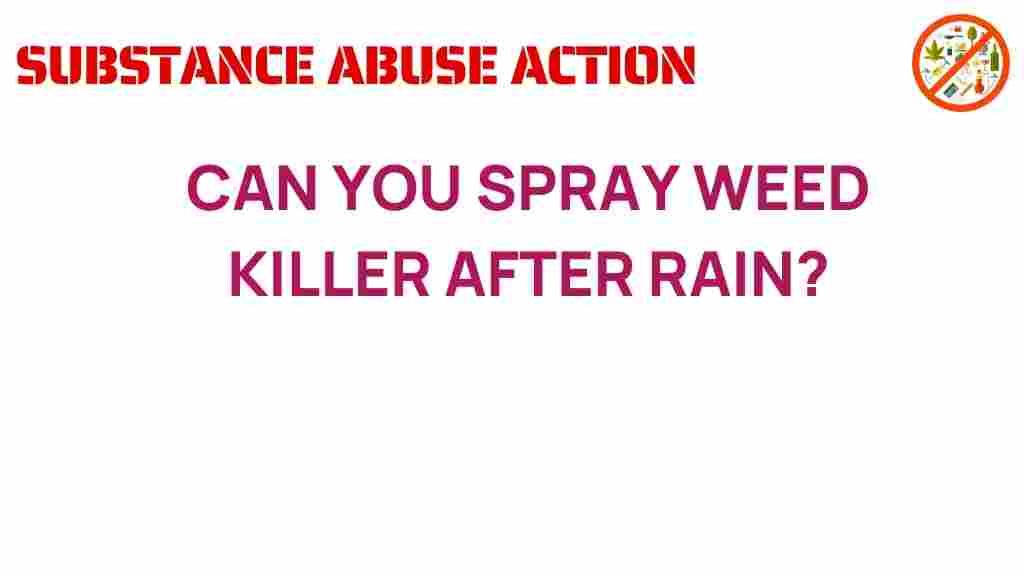The Truth About Spraying Weed Killer After Rain
When it comes to maintaining a healthy garden or lawn, the timing of applying weed killer can significantly affect its effectiveness. Many gardeners often wonder whether they can spray herbicides after it rains. This article delves into the complexities of applying weed killer in relation to rain, providing essential insights on gardening, lawn care, and the environmental impact of these chemicals.
Understanding Weed Killers and Their Function
Weed killers, or herbicides, are designed to eliminate unwanted plants that compete with your desired flora for nutrients, water, and sunlight. There are two main types of herbicides:
- Selective Herbicides: Target specific types of weeds without harming the surrounding plants.
- Non-Selective Herbicides: Kill all vegetation they come into contact with, useful for clearing entire areas.
Knowing the type of weed killer you are using is crucial for effective application. The timing of application, especially concerning rain, plays a vital role in how well these products work.
The Importance of Timing in Lawn Care
Timing is a critical factor in the application of weed killer. Here are some key points to consider:
- Most herbicides require a dry surface to adhere effectively to plant leaves.
- Applying after heavy rainfall can wash away the product before it has a chance to work.
- Optimal conditions typically include applying weed killer when rain is not forecasted for at least 24 hours.
The Effectiveness of Spraying Weed Killer After Rain
Applying weed killer immediately after rain can drastically reduce its effectiveness. Here’s why:
- Runoff: If the ground is saturated, the herbicide can be washed away, leading to poor results.
- Absorption: Wet leaves may not absorb the chemical properly, reducing its effectiveness.
- Timing: Wait at least 24 hours after a light rain and up to a week after heavy rains before applying herbicides.
To maximize the impact of your weed killer, it’s essential to consider the timing of your application in relation to recent rainfall.
Best Practices for Applying Weed Killer
To ensure you are using weed killer effectively, follow these best practices:
- Check the weather forecast: Avoid applying herbicides if rain is expected within 24 hours.
- Wait for dry conditions: Apply weed killer when the foliage is dry and the soil is not overly saturated.
- Follow manufacturer instructions: Each product has specific guidelines that should be adhered to for optimal results.
- Consider the type of weeds: Different weeds may require different application methods or timing.
Environmental Impact of Weed Killers
While herbicides are effective at controlling unwanted plants, they also pose several environmental risks:
- Water contamination: Rain can wash weed killer into local waterways, affecting aquatic life.
- Soil health: Prolonged use of herbicides can degrade soil quality and harm beneficial microorganisms.
- Impact on non-target plants: Drift can affect nearby gardens, harming plants you wish to keep.
To mitigate these risks, consider using organic alternatives or practicing integrated weed management strategies.
Step-by-Step Process for Applying Weed Killer
Here’s a simple step-by-step guide to applying weed killer effectively:
- Identify the weeds: Know what you’re dealing with to select the right herbicide.
- Choose the right product: Select a herbicide that targets your specific weed type.
- Check the weather: Ensure no rain is forecasted for at least 24 hours.
- Prepare the area: Mow the lawn and remove debris to maximize exposure of the weeds.
- Apply the herbicide: Use a sprayer for even coverage, avoiding drift onto desirable plants.
- Monitor weather conditions: Keep an eye on the forecast for the next few days.
- Evaluate effectiveness: Check the treated area after a week; retreat if necessary.
Troubleshooting Common Issues
If you’re not seeing the desired results from your weed killer, consider these troubleshooting tips:
- Insufficient coverage: Ensure you’ve sprayed all affected areas thoroughly.
- Resistant weeds: Some weeds may require stronger or alternative treatments.
- Timing: Reassess the timing; was there rain soon after application?
- Check expiration dates: Old products may lose potency and effectiveness.
If problems persist, you may want to consult a gardening professional or refer to resources like this gardening guide for additional strategies.
Conclusion
Applying weed killer after rain can significantly hinder its effectiveness and impact your overall lawn care efforts. Understanding the timing and environmental considerations is crucial for successful gardening. By following the best practices outlined in this article, you can ensure that your herbicides work efficiently, promoting a healthier garden while minimizing environmental impact. Remember, responsible use of weed killer not only supports your gardening goals but also protects the ecosystem around you.
For more information about gardening and lawn care, visit our resource page.
This article is in the category Treatment and created by SubstanceAbuseAction Team

2 thoughts on “The Truth About Spraying Weed Killer After Rain: What You Need to Know”